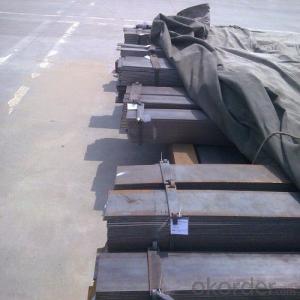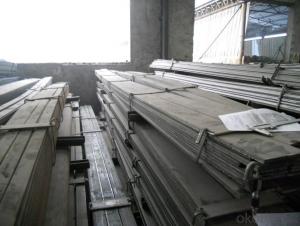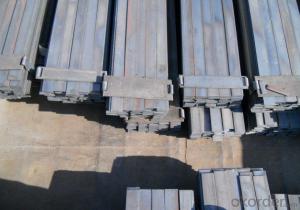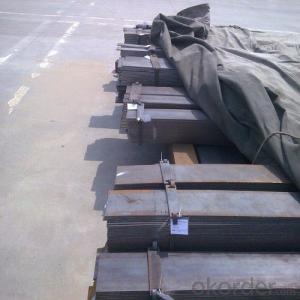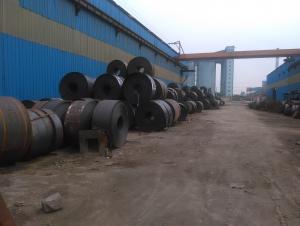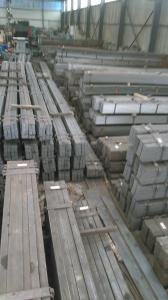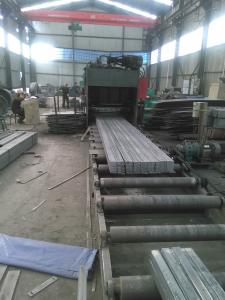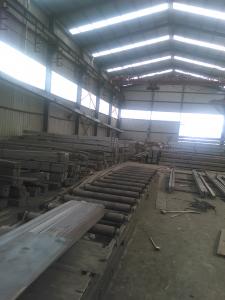Hot Rolled Flat Bar with Material Grade Q235
- Loading Port:
- Tianjin
- Payment Terms:
- TT OR LC
- Min Order Qty:
- 25 m.t.
- Supply Capability:
- 10000 m.t./month
OKorder Service Pledge
OKorder Financial Service
You Might Also Like
OKorder is offering high quality Flat Bar at great prices with worldwide shipping. Our supplier is a world-class manufacturer of steel, with our products utilized the world over. OKorder annually supplies products to European, North American and Asian markets. We provide quotations within 24 hours of receiving an inquiry and guarantee competitive prices.
Product Applications:
Slit Cutting Flat Bars are ideal for structural applications and are widely used in the construction of buildings and bridges, and the manufacturing, petrochemical, and transportation industries.
Product Advantages:
OKorder's Flats Bars are durable, strong, and resist corrosion.
Main Product Features:
· Premium quality
· Prompt delivery & seaworthy packing (30 days after receiving deposit)
· Corrosion resistance
· Can be recycled and reused
· Mill test certification
· Professional Service
· Competitive pricing
Product Specifications:
Manufacture: Hot Rolled
Grade: Q195 – 235
Certificates: ISO, SGS, BV, CIQ
Length: 6m – 12m, as per customer request
Packaging: Export packing, nude packing, bundled
Chemical composition of Q235
Alloy No | Grade | Element(%) | ||||
C
| Mn
| S
| P
| Si
| ||
Q235
|
B
|
0.12—0.20 |
0.3—0.7 |
≤0.045 |
≤0.045
|
≤0.3
|
Physical properties of Q235
Alloy No | Grade | Yielding strength point(Mpa) | Tensile strength (Mpa) | Elongation after fracture(%) | ||||||
Thickness (mm) | Thickness (mm) | |||||||||
≤16 | >16--40 | >40--60 | >60--100 | ≤16 | >16--40 | >40--60 | >60--100 | |||
≥ | ≥ | |||||||||
Q235 |
B |
235 |
225 |
215 |
205 |
375--500 |
26 |
25 |
24 |
23 |
FAQ:
Q1: How soon can we receive the product after purchase?
A1: Within three days of placing an order, we will begin production. The specific shipping date is dependent upon international and government factors, but is typically 7 to 10 workdays.
Q2: How do we guarantee the quality of our products?
A2: We have established an advanced quality management system which conducts strict quality tests at every step, from raw materials to the final product. At the same time, we provide extensive follow-up service assurances as required.
Q3: The products are invoicing on theoritical weight or on actual weight?
A3: We can do it in both manners, according to the customers' request.
Images:
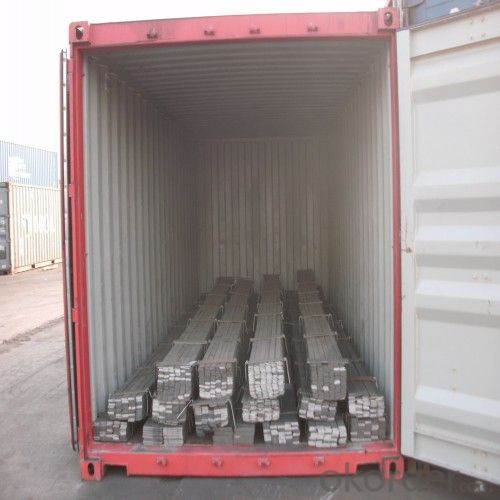
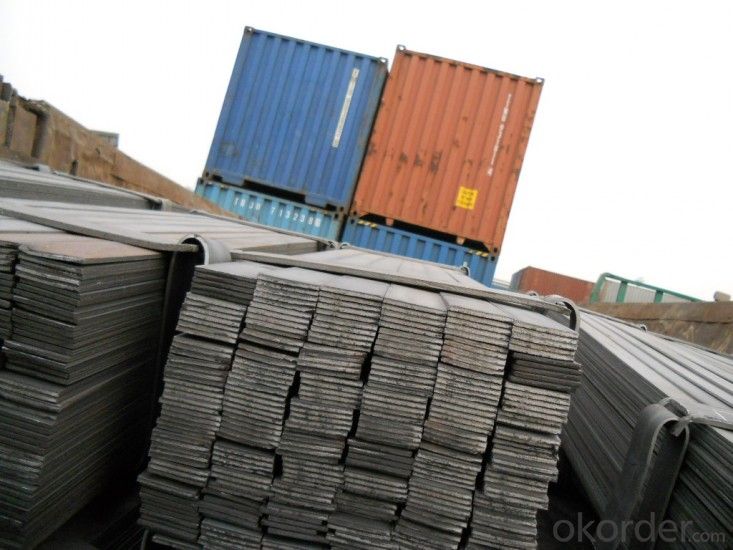
- Q:Are steel flat bars suitable for fabrication of support structures?
- Yes, steel flat bars are suitable for fabrication of support structures. Steel is known for its strength and durability, and flat bars provide a stable and sturdy base for supporting various structures. They can be easily welded, bolted, or attached to other components, making them versatile for different fabrication needs.
- Q:What are the different sizes of steel flat bars?
- To accommodate different needs and purposes, steel flat bars are available in various sizes. Examples of common sizes include 1/8 inch thick by 1/2 inch wide, 1/4 inch thick by 1/2 inch wide, 3/8 inch thick by 1/2 inch wide, and 1/2 inch thick by 1/2 inch wide. However, these are merely a few illustrations, as steel flat bars are obtainable in a wide assortment of thicknesses and widths. Some larger options might be 1 inch thick by 4 inches wide or even larger. The appropriate size of a steel flat bar required will rely on the intended usage, load-bearing capacity, and the desired strength of the steel. It is essential to consult a steel supplier or refer to an industry standard to ascertain the suitable size for a particular application.
- Q:Are steel flat bars suitable for making industrial equipment?
- Yes, steel flat bars are suitable for making industrial equipment. Steel flat bars are known for their strength, durability, and versatility, making them ideal for various applications in the industrial sector. They can be used to construct frames, supports, and structures for machinery and equipment. Steel flat bars also offer excellent load-bearing capabilities, making them suitable for heavy-duty industrial equipment. Additionally, they can be easily welded, cut, and shaped to meet specific design requirements, allowing for customization and flexibility in equipment manufacturing. Overall, steel flat bars are a reliable and widely used material in the production of industrial equipment due to their strength, durability, and adaptability.
- Q:How do steel flat bars resist bending or twisting?
- Steel flat bars resist bending or twisting due to their inherent strength and rigidity. Steel is a strong and durable material that is able to withstand applied forces without easily deforming. The flat shape of the bar also contributes to its resistance to bending or twisting, as it distributes the forces evenly across its width. The resistance to bending or twisting of steel flat bars can be further enhanced by their cross-sectional shape. Most steel flat bars have a rectangular or square cross-section, which provides greater stability compared to other shapes. The flat surfaces of the bar help to distribute the bending or twisting forces evenly, preventing concentrated stress points that could lead to deformation. Additionally, the manufacturing process of steel flat bars involves heating the steel to a high temperature and then cooling it rapidly, a process known as quenching and tempering. This process increases the strength and toughness of the steel, making it more resistant to bending or twisting. Furthermore, the composition of the steel used in flat bars can also affect their resistance to bending or twisting. Alloying elements such as carbon, manganese, and chromium can be added to the steel to enhance its strength and resistance to deformation. Overall, the combination of the inherent strength and rigidity of steel, the flat shape of the bar, the cross-sectional design, and the manufacturing process contribute to the ability of steel flat bars to resist bending or twisting.
- Q:What is the difference between a steel flat bar and a steel angle bar?
- A steel flat bar is a long, rectangular-shaped bar with even width and thickness throughout its length, while a steel angle bar has a right angle or L shape, with two legs of equal or varying lengths. The main difference lies in their shapes, where the flat bar is flat and the angle bar has a distinct angular shape.
- Q:What's the difference between stainless steel flat bar 304 and 316?
- 316 stainless steel flat type is 316, the material is stainless steel. The stainless steel should be a bundle of delivery, the bundle passes, bundle length should be specified. Stainless steel flat is generally naked, delivery, transportation and storage are required to pay attention to moisture.
- Q:How are steel flat bars used in construction?
- Steel flat bars have a wide range of applications in construction. They are commonly used to provide structural support in buildings and infrastructure. By serving as beams or columns, they offer stability and strength to structures. Construction projects also make use of steel flat bars for framing and bracing purposes. These bars can be used to create robust frameworks for walls, roofs, and floors, forming a sturdy foundation for the rest of the building components. Furthermore, steel flat bars are utilized to reinforce concrete structures. They are often embedded within concrete slabs or walls to enhance strength and prevent cracking or structural failure. These bars act as tension members, evenly distributing forces and improving the overall durability of the concrete structure. Moreover, steel flat bars are employed in the manufacturing of various construction components like brackets, connectors, and supports. These components play a crucial role in joining different elements of a building together, ensuring stability and functionality. In conclusion, steel flat bars are indispensable in construction due to their ability to provide structural support, reinforce concrete, and manufacture essential components. Their versatility, strength, and durability make them a popular choice for many construction projects.
- Q:What are the load capacities of steel flat bars?
- The load capacities of steel flat bars vary depending on their dimensions and the specific grade of steel used. However, steel flat bars are known for their high strength and load-bearing capacity, making them suitable for various applications such as construction, manufacturing, and structural support. It is important to consult engineering specifications and calculations to determine the precise load capacities for a specific steel flat bar.
- Q:Are steel flat bars used in the automotive industry?
- Yes, steel flat bars are commonly used in the automotive industry. They are primarily used in various applications such as chassis frames, suspension components, seat frames, and door reinforcements. Steel flat bars offer several advantages in automotive manufacturing, including high strength, durability, and cost-effectiveness. Their versatility and ability to be easily formed and welded make them an ideal choice for many automotive structural and non-structural parts. Additionally, steel flat bars offer excellent resistance to impact and fatigue, ensuring the safety and longevity of vehicles.
- Q:What are the different methods of surface cleaning for steel flat bars?
- There are several methods of surface cleaning for steel flat bars, including mechanical cleaning, chemical cleaning, and abrasive blasting. Mechanical cleaning involves using tools such as wire brushes or sandpaper to physically remove dirt, rust, or other contaminants from the surface. Chemical cleaning involves applying cleaning agents or solvents to dissolve or remove contaminants. Abrasive blasting uses high-pressure air or water to propel abrasive particles against the surface, effectively removing dirt, rust, or scale. Each method has its advantages and is chosen based on the specific requirements and conditions of the steel flat bars.
1. Manufacturer Overview |
|
|---|---|
| Location | |
| Year Established | |
| Annual Output Value | |
| Main Markets | |
| Company Certifications | |
2. Manufacturer Certificates |
|
|---|---|
| a) Certification Name | |
| Range | |
| Reference | |
| Validity Period | |
3. Manufacturer Capability |
|
|---|---|
| a)Trade Capacity | |
| Nearest Port | |
| Export Percentage | |
| No.of Employees in Trade Department | |
| Language Spoken: | |
| b)Factory Information | |
| Factory Size: | |
| No. of Production Lines | |
| Contract Manufacturing | |
| Product Price Range | |
Send your message to us
Hot Rolled Flat Bar with Material Grade Q235
- Loading Port:
- Tianjin
- Payment Terms:
- TT OR LC
- Min Order Qty:
- 25 m.t.
- Supply Capability:
- 10000 m.t./month
OKorder Service Pledge
OKorder Financial Service
Similar products
New products
Hot products
Hot Searches
Related keywords
